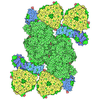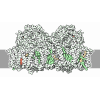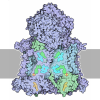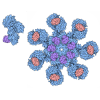+ Open data
Open data
- Basic information
Basic information
| Entry | Database: PDB / ID: 8xr6 | ||||||
|---|---|---|---|---|---|---|---|
| Title | Cryo-EM structure of cryptophyte photosystem II | ||||||
 Components Components |
| ||||||
 Keywords Keywords | PHOTOSYNTHESIS / Cryptophyte / Photosystem II / evolution | ||||||
| Function / homology |  Function and homology information Function and homology informationthylakoid membrane / photosystem II stabilization / photosystem II reaction center / photosystem II / oxidoreductase activity, acting on diphenols and related substances as donors, oxygen as acceptor / photosynthetic electron transport chain / photosystem II / response to herbicide / chlorophyll binding / photosynthetic electron transport in photosystem II ...thylakoid membrane / photosystem II stabilization / photosystem II reaction center / photosystem II / oxidoreductase activity, acting on diphenols and related substances as donors, oxygen as acceptor / photosynthetic electron transport chain / photosystem II / response to herbicide / chlorophyll binding / photosynthetic electron transport in photosystem II / : / phosphate ion binding / chloroplast thylakoid membrane / photosynthesis, light reaction / photosynthesis / chloroplast / respiratory electron transport chain / oxidoreductase activity / electron transfer activity / protein stabilization / iron ion binding / heme binding Similarity search - Function | ||||||
| Biological species |  Chroomonas placoidea (eukaryote) Chroomonas placoidea (eukaryote) | ||||||
| Method | ELECTRON MICROSCOPY / single particle reconstruction / cryo EM / Resolution: 2.53 Å | ||||||
 Authors Authors | Li, K. / Zhao, L.S. / Zhang, Y.Z. / Liu, L.N. | ||||||
| Funding support |  China, 1items China, 1items
| ||||||
 Citation Citation |  Journal: Nat Commun / Year: 2024 Journal: Nat Commun / Year: 2024Title: Structure of cryptophyte photosystem II-light-harvesting antennae supercomplex. Authors: Yu-Zhong Zhang / Kang Li / Bing-Yue Qin / Jian-Ping Guo / Quan-Bao Zhang / Dian-Li Zhao / Xiu-Lan Chen / Jun Gao / Lu-Ning Liu / Long-Sheng Zhao /   Abstract: Cryptophytes are ancestral photosynthetic organisms evolved from red algae through secondary endosymbiosis. They have developed alloxanthin-chlorophyll a/c2-binding proteins (ACPs) as light- ...Cryptophytes are ancestral photosynthetic organisms evolved from red algae through secondary endosymbiosis. They have developed alloxanthin-chlorophyll a/c2-binding proteins (ACPs) as light-harvesting complexes (LHCs). The distinctive properties of cryptophytes contribute to efficient oxygenic photosynthesis and underscore the evolutionary relationships of red-lineage plastids. Here we present the cryo-electron microscopy structure of the Photosystem II (PSII)-ACPII supercomplex from the cryptophyte Chroomonas placoidea. The structure includes a PSII dimer and twelve ACPII monomers forming four linear trimers. These trimers structurally resemble red algae LHCs and cryptophyte ACPI trimers that associate with Photosystem I (PSI), suggesting their close evolutionary links. We also determine a Chl a-binding subunit, Psb-γ, essential for stabilizing PSII-ACPII association. Furthermore, computational calculation provides insights into the excitation energy transfer pathways. Our study lays a solid structural foundation for understanding the light-energy capture and transfer in cryptophyte PSII-ACPII, evolutionary variations in PSII-LHCII, and the origin of red-lineage LHCIIs. | ||||||
| History |
|
- Structure visualization
Structure visualization
| Structure viewer | Molecule:  Molmil Molmil Jmol/JSmol Jmol/JSmol |
|---|
- Downloads & links
Downloads & links
- Download
Download
| PDBx/mmCIF format |  8xr6.cif.gz 8xr6.cif.gz | 1.8 MB | Display |  PDBx/mmCIF format PDBx/mmCIF format |
|---|---|---|---|---|
| PDB format |  pdb8xr6.ent.gz pdb8xr6.ent.gz | 1.5 MB | Display |  PDB format PDB format |
| PDBx/mmJSON format |  8xr6.json.gz 8xr6.json.gz | Tree view |  PDBx/mmJSON format PDBx/mmJSON format | |
| Others |  Other downloads Other downloads |
-Validation report
| Summary document |  8xr6_validation.pdf.gz 8xr6_validation.pdf.gz | 18.6 MB | Display |  wwPDB validaton report wwPDB validaton report |
|---|---|---|---|---|
| Full document |  8xr6_full_validation.pdf.gz 8xr6_full_validation.pdf.gz | 19.2 MB | Display | |
| Data in XML |  8xr6_validation.xml.gz 8xr6_validation.xml.gz | 309.8 KB | Display | |
| Data in CIF |  8xr6_validation.cif.gz 8xr6_validation.cif.gz | 406.3 KB | Display | |
| Arichive directory |  https://data.pdbj.org/pub/pdb/validation_reports/xr/8xr6 https://data.pdbj.org/pub/pdb/validation_reports/xr/8xr6 ftp://data.pdbj.org/pub/pdb/validation_reports/xr/8xr6 ftp://data.pdbj.org/pub/pdb/validation_reports/xr/8xr6 | HTTPS FTP |
-Related structure data
| Related structure data |  38596MC M: map data used to model this data C: citing same article ( |
|---|---|
| Similar structure data | Similarity search - Function & homology  F&H Search F&H Search |
- Links
Links
- Assembly
Assembly
| Deposited unit | 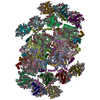
|
|---|---|
| 1 |
|
- Components
Components
-Photosystem II ... , 13 types, 26 molecules aABbDdHhIiJjKkLlTtVvXxYyZz
| #1: Protein | Mass: 39590.910 Da / Num. of mol.: 2 / Source method: isolated from a natural source / Source: (natural)  Chroomonas placoidea (eukaryote) / References: UniProt: A0A222AI41, photosystem II Chroomonas placoidea (eukaryote) / References: UniProt: A0A222AI41, photosystem II#8: Protein | Mass: 56354.172 Da / Num. of mol.: 2 / Source method: isolated from a natural source / Source: (natural)  Chroomonas placoidea (eukaryote) / References: UniProt: A0A222AIE3 Chroomonas placoidea (eukaryote) / References: UniProt: A0A222AIE3#10: Protein | Mass: 39216.812 Da / Num. of mol.: 2 / Source method: isolated from a natural source / Source: (natural)  Chroomonas placoidea (eukaryote) / References: UniProt: A0A222AI37, photosystem II Chroomonas placoidea (eukaryote) / References: UniProt: A0A222AI37, photosystem II#13: Protein | Mass: 7519.887 Da / Num. of mol.: 2 / Source method: isolated from a natural source / Source: (natural)  Chroomonas placoidea (eukaryote) / References: UniProt: A0A222AIE4 Chroomonas placoidea (eukaryote) / References: UniProt: A0A222AIE4#14: Protein/peptide | Mass: 4424.081 Da / Num. of mol.: 2 / Source method: isolated from a natural source / Source: (natural)  Chroomonas placoidea (eukaryote) / References: UniProt: A0A222AI80 Chroomonas placoidea (eukaryote) / References: UniProt: A0A222AI80#15: Protein/peptide | Mass: 3964.609 Da / Num. of mol.: 2 / Source method: isolated from a natural source / Source: (natural)  Chroomonas placoidea (eukaryote) / References: UniProt: A0A222AI54 Chroomonas placoidea (eukaryote) / References: UniProt: A0A222AI54#16: Protein/peptide | Mass: 5005.114 Da / Num. of mol.: 2 / Source method: isolated from a natural source / Source: (natural)  Chroomonas placoidea (eukaryote) / References: UniProt: A0A222AIA0 Chroomonas placoidea (eukaryote) / References: UniProt: A0A222AIA0#17: Protein/peptide | Mass: 4363.087 Da / Num. of mol.: 2 / Source method: isolated from a natural source / Source: (natural)  Chroomonas placoidea (eukaryote) / References: UniProt: A0A222AI58 Chroomonas placoidea (eukaryote) / References: UniProt: A0A222AI58#22: Protein/peptide | Mass: 3664.447 Da / Num. of mol.: 2 / Source method: isolated from a natural source / Source: (natural)  Chroomonas placoidea (eukaryote) / References: UniProt: A0A222AID2 Chroomonas placoidea (eukaryote) / References: UniProt: A0A222AID2#24: Protein | Mass: 17708.234 Da / Num. of mol.: 2 / Source method: isolated from a natural source / Source: (natural)  Chroomonas placoidea (eukaryote) / References: UniProt: A0A222AI35 Chroomonas placoidea (eukaryote) / References: UniProt: A0A222AI35#26: Protein/peptide | Mass: 4149.939 Da / Num. of mol.: 2 / Source method: isolated from a natural source / Source: (natural)  Chroomonas placoidea (eukaryote) / References: UniProt: A0A222AI61 Chroomonas placoidea (eukaryote) / References: UniProt: A0A222AI61#27: Protein/peptide | Mass: 3763.581 Da / Num. of mol.: 2 / Source method: isolated from a natural source / Source: (natural)  Chroomonas placoidea (eukaryote) / References: UniProt: A0A222AI69 Chroomonas placoidea (eukaryote) / References: UniProt: A0A222AI69#28: Protein | Mass: 6573.990 Da / Num. of mol.: 2 / Source method: isolated from a natural source / Source: (natural)  Chroomonas placoidea (eukaryote) / References: UniProt: A0A222AI96 Chroomonas placoidea (eukaryote) / References: UniProt: A0A222AI96 |
|---|
-Protein , 12 types, 24 molecules 041728395g6pCcNnOoQqUuWw
| #2: Protein | Mass: 23658.529 Da / Num. of mol.: 2 / Source method: isolated from a natural source / Source: (natural)  Chroomonas placoidea (eukaryote) Chroomonas placoidea (eukaryote)#3: Protein | Mass: 23755.605 Da / Num. of mol.: 2 / Source method: isolated from a natural source / Source: (natural)  Chroomonas placoidea (eukaryote) Chroomonas placoidea (eukaryote)#4: Protein | Mass: 22144.328 Da / Num. of mol.: 2 / Source method: isolated from a natural source / Source: (natural)  Chroomonas placoidea (eukaryote) Chroomonas placoidea (eukaryote)#5: Protein | Mass: 24136.174 Da / Num. of mol.: 2 / Source method: isolated from a natural source / Source: (natural)  Chroomonas placoidea (eukaryote) Chroomonas placoidea (eukaryote)#6: Protein | Mass: 23400.123 Da / Num. of mol.: 2 / Source method: isolated from a natural source / Source: (natural)  Chroomonas placoidea (eukaryote) Chroomonas placoidea (eukaryote)#7: Protein | Mass: 25022.043 Da / Num. of mol.: 2 / Source method: isolated from a natural source / Source: (natural)  Chroomonas placoidea (eukaryote) Chroomonas placoidea (eukaryote)#9: Protein | Mass: 52077.359 Da / Num. of mol.: 2 / Source method: isolated from a natural source / Source: (natural)  Chroomonas placoidea (eukaryote) Chroomonas placoidea (eukaryote)#19: Protein | Mass: 31745.117 Da / Num. of mol.: 2 / Source method: isolated from a natural source / Source: (natural)  Chroomonas placoidea (eukaryote) Chroomonas placoidea (eukaryote)#20: Protein | Mass: 32104.006 Da / Num. of mol.: 2 / Source method: isolated from a natural source / Source: (natural)  Chroomonas placoidea (eukaryote) Chroomonas placoidea (eukaryote)#21: Protein | Mass: 15748.910 Da / Num. of mol.: 2 / Source method: isolated from a natural source / Source: (natural)  Chroomonas placoidea (eukaryote) Chroomonas placoidea (eukaryote)#23: Protein | Mass: 13211.063 Da / Num. of mol.: 2 / Source method: isolated from a natural source / Source: (natural)  Chroomonas placoidea (eukaryote) Chroomonas placoidea (eukaryote)#25: Protein | Mass: 13751.879 Da / Num. of mol.: 2 / Source method: isolated from a natural source / Source: (natural)  Chroomonas placoidea (eukaryote) Chroomonas placoidea (eukaryote) |
|---|
-Cytochrome b559 subunit ... , 2 types, 4 molecules EeFf
| #11: Protein | Mass: 9505.693 Da / Num. of mol.: 2 / Source method: isolated from a natural source / Source: (natural)  Chroomonas placoidea (eukaryote) / References: UniProt: A0A222AI74 Chroomonas placoidea (eukaryote) / References: UniProt: A0A222AI74#12: Protein/peptide | Mass: 4845.769 Da / Num. of mol.: 2 / Source method: isolated from a natural source / Source: (natural)  Chroomonas placoidea (eukaryote) / References: UniProt: A0A222AI51 Chroomonas placoidea (eukaryote) / References: UniProt: A0A222AI51 |
|---|
-Protein/peptide / Sugars , 2 types, 10 molecules Mm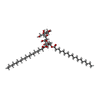

| #18: Protein/peptide | Mass: 3933.613 Da / Num. of mol.: 2 / Source method: isolated from a natural source / Source: (natural)  Chroomonas placoidea (eukaryote) Chroomonas placoidea (eukaryote)#43: Sugar | ChemComp-DGD / |
|---|
-Non-polymers , 16 types, 456 molecules 

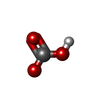

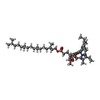

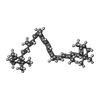
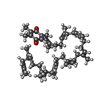
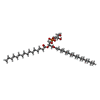


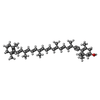
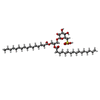
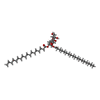

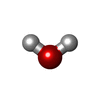















| #29: Chemical | | #30: Chemical | #31: Chemical | #32: Chemical | #33: Chemical | ChemComp-CLA / #34: Chemical | ChemComp-PHO / #35: Chemical | ChemComp-8CT / ( #36: Chemical | ChemComp-PL9 / #37: Chemical | ChemComp-LHG / #38: Chemical | ChemComp-KC2 / #39: Chemical | ChemComp-II0 / ( #40: Chemical | ChemComp-IHT / ( #41: Chemical | ChemComp-SQD / #42: Chemical | ChemComp-LMG / #44: Chemical | ChemComp-HEM / #45: Water | ChemComp-HOH / | |
|---|
-Details
| Has ligand of interest | Y |
|---|---|
| Has protein modification | N |
-Experimental details
-Experiment
| Experiment | Method: ELECTRON MICROSCOPY |
|---|---|
| EM experiment | Aggregation state: PARTICLE / 3D reconstruction method: single particle reconstruction |
- Sample preparation
Sample preparation
| Component | Name: Photosystem II of cryptophyte / Type: COMPLEX Entity ID: #3-#5, #2, #6-#7, #19, #1, #8-#18, #20-#25, #27-#28, #26 Source: NATURAL |
|---|---|
| Molecular weight | Value: 1.1 MDa / Experimental value: NO |
| Source (natural) | Organism:  Chroomonas placoidea (eukaryote) Chroomonas placoidea (eukaryote) |
| Buffer solution | pH: 6.5 |
| Specimen | Embedding applied: NO / Shadowing applied: NO / Staining applied: NO / Vitrification applied: YES |
| Vitrification | Cryogen name: ETHANE |
- Electron microscopy imaging
Electron microscopy imaging
| Experimental equipment |  Model: Titan Krios / Image courtesy: FEI Company |
|---|---|
| Microscopy | Model: FEI TITAN KRIOS |
| Electron gun | Electron source:  FIELD EMISSION GUN / Accelerating voltage: 300 kV / Illumination mode: SPOT SCAN FIELD EMISSION GUN / Accelerating voltage: 300 kV / Illumination mode: SPOT SCAN |
| Electron lens | Mode: BRIGHT FIELD / Nominal defocus max: 1800 nm / Nominal defocus min: 1000 nm / Cs: 2.7 mm |
| Image recording | Electron dose: 50 e/Å2 / Film or detector model: GATAN K3 BIOQUANTUM (6k x 4k) |
- Processing
Processing
| CTF correction | Type: PHASE FLIPPING AND AMPLITUDE CORRECTION |
|---|---|
| 3D reconstruction | Resolution: 2.53 Å / Resolution method: FSC 0.143 CUT-OFF / Num. of particles: 168683 / Symmetry type: POINT |
 Movie
Movie Controller
Controller



 PDBj
PDBj